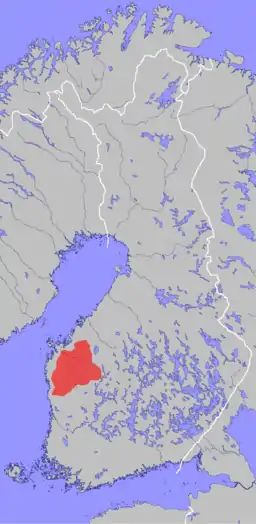
South Ostrobothnian dialect (Finnish: Etelä-Pohjanmaan murre) is a Western Finnish dialect. It is traditionally spoken in the region of South Ostrobothnia and parts of Coastal Ostrobothnia.[1] The South Ostrobothnian dialect has many features that are unique to the region of South Ostrobothnia.[2]
South Ostrobothnian is surrounded by 4 different forms of speech, Savonian, Tavastian, Southwestern Finnish (Northern Satakunta) and Swedish. Savonian has mainly influenced eastern South Ostrobothnian, Tavastian has influenced southeastern South Ostrobothnian and western South Ostrobothnian was influenced more by Swedish.[3]
Features
- Written Finnish /d/ has changed into /r/
- saara "get" (Written: saada)
- Written Finnish ts is tt
- mettä "forest" (Written: metsä)
- Diphthongs
- uo, yö and ie are ua, yä and iä in the northern regions of South Ostrobothnian - nuari "young" (Written: nuori)
- Middle vowel
- tylysä "boring" (Written: tylsä)
- Inessive ending
- maas(s) "in the ground" (Written: maassa)
- Vowel i-
- i- in written Finnish is replaced by a long vowel - keltaanen "yellow" (Written: keltainen)
- Consonant gradiation
- jalka - jalaat "foot" - "feet" (Written: jalka - jalat)
- Verb conjugation
- tuomma "we bring" - toimma "we brought" (Written: tuomme - toimme), tuutta "you come" - tulitta "you came" (Written: tulette - tulitte)[2]
Vocabulary
- fiini 'nice' (Written: hieno)
- (f)likka 'girl' (Written: tyttö)
- friiari 'suitor' (Written: kosija)
- föli(j)ys 'with' (Written: mukana)
- hantuuki 'hand towel' (Written: käsipyyhe)
- (k)lasi 'window' / silimä(k)lasit 'eyeglasses' (Written: ikkuna/silmälasit )
- kranni 'neighbour' (Written: naapuri)
- kränä 'quarrel' (Written: riita)
- notta/niij jotta 'so that' (Written: niin, että)
- perna 'potato' (Written: peruna)
- pirättää 'stop' (Written: pidättää)
- praatata 'chat' (Written: jutella)
- pruukata 'be used to' (Written: olla tapana )
- pöröttää 'reverse' (Written: peruuttaa)
- moon 'I am' (Written: (minä) olen)
- soot 'you are' (Written: (sinä) olet)
- son 'he/she/"it" is' (Written: hän/"se" on )
- moomma 'we are' (Written: (me) olemme )
- tootta 'you are' (Written: (te) olette)
- non 'they are' (Written: he/"ne" ovat)[4][5]
Example
Example from Kurikka, 11.6.1965[6]
Kuinkas sitä maata silloon vilijeltihin, kun te sellaanen pieni poika vielä olit(ta)?
– No, ei silloon ollu, sitten apulannoosta juuri mitää tietua vielä. Joku taloollinen osti luujauhoja, mutta torpparit ei niitä pystyny ostamahan. Luujauho, soli ensimmäänen apulanta, mitä minä muistan, joton käytetty.
Written:
Kuinka maata viljeltiin silloin, kun olit(te) vielä pieni poika?
– No, ei silloin ollut apulannoitteista vielä juuri mitään tietoa. Joku talollinen osti luujauhoja, mutta torpparit eivät niitä pystyneet ostamaan. Luujauho oli ensimmäinen apulannoite, mitä muistan käytetyn.
Approximate English translation:
How did people farm the land when you were still such a small boy?
– Well, there wasn't hardly any information about artificial fertilizers at the time yet. Some houseowner bought bone powder, but tenant farmers could not buy them. The bone powder, it was the first kind of artificial fertiliser I remember was used.
See also
References
- ↑ "Suomen murteet". Kotimaisten kielten keskus (in Finnish). Retrieved 2022-03-23.
- 1 2 "Eteläpohjalaisten murteiden piirteitä". sokl.uef.fi. Retrieved 2021-05-26.
- ↑ Kalevi, Wiik (2004). Suomen Murteet Kvanttinen tutkimus. Helsinki: Suomalaisen Kirjallisuuden seura. pp. 150–151.
- ↑ "Kurikka-Suomi -sanakirja". www.elisanet.fi. Retrieved 2021-05-26.
- ↑ "Murresanakirja". Visit Seinäjoki (in Finnish). Retrieved 2021-05-26.
- ↑ "Kurikan näyte". Kotimaisten kielten keskus (in Finnish). Retrieved 2021-05-26.